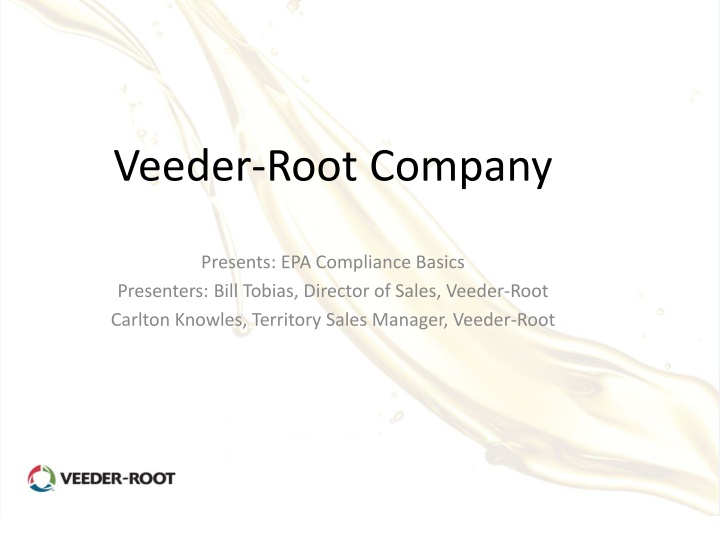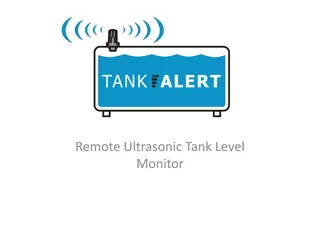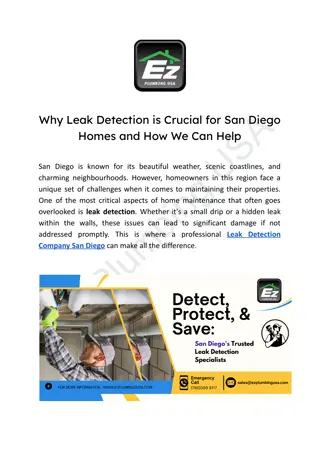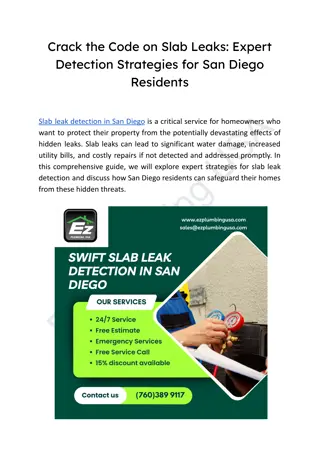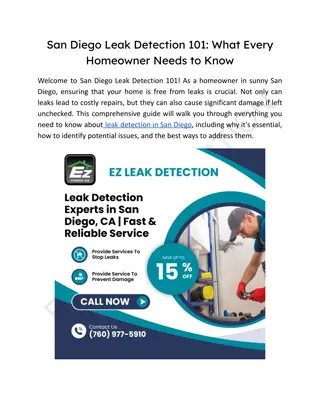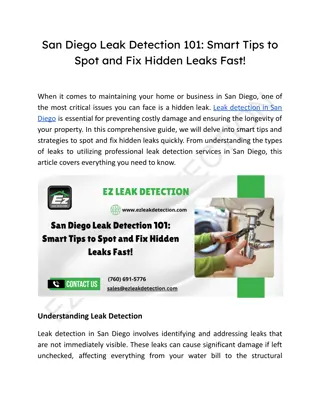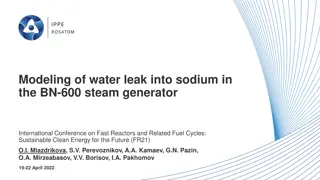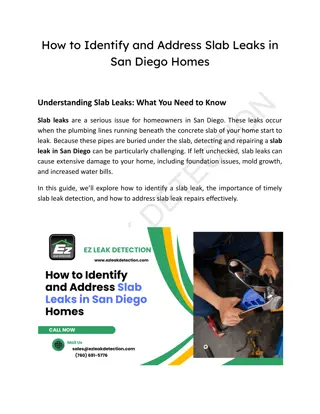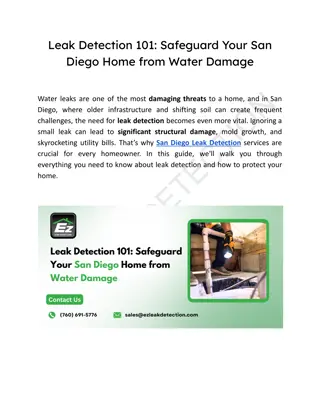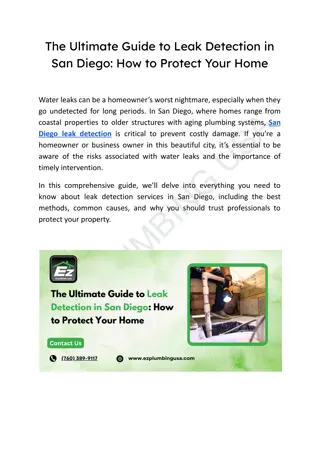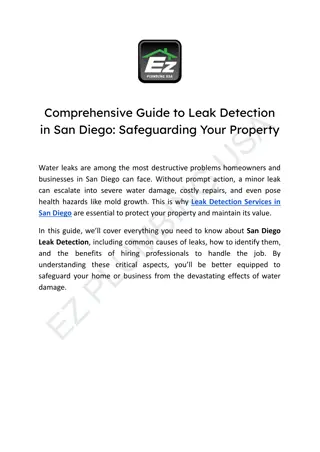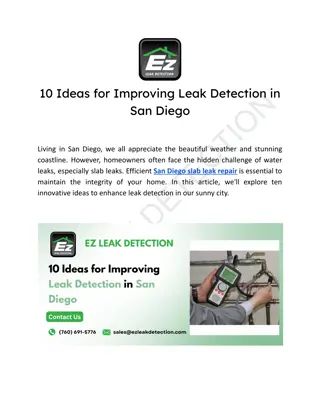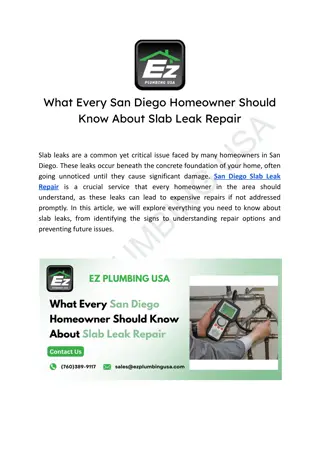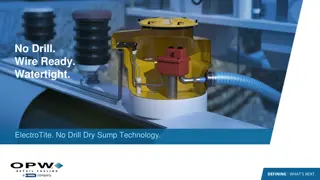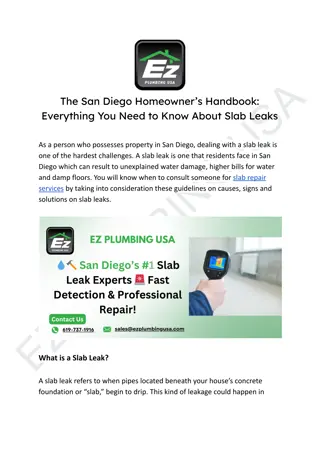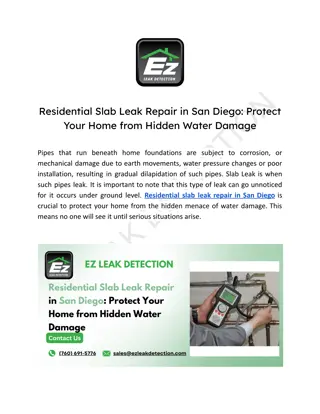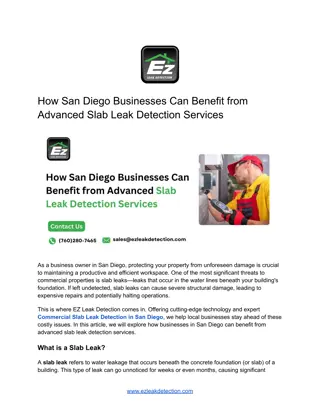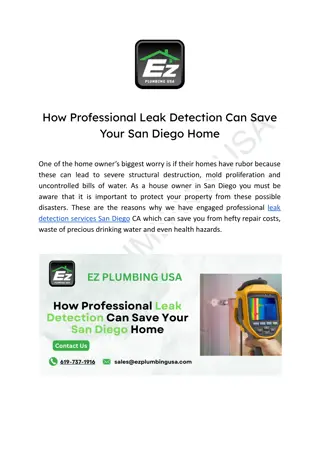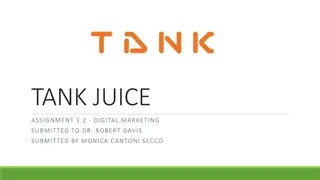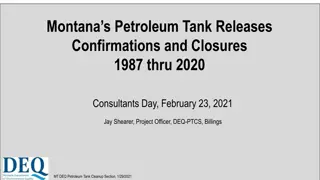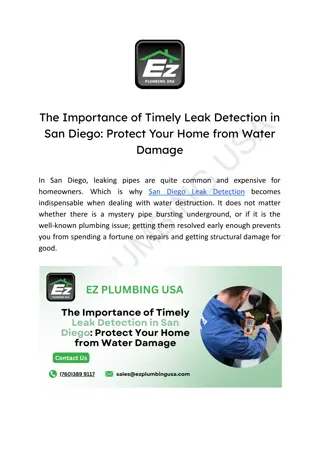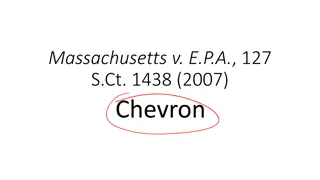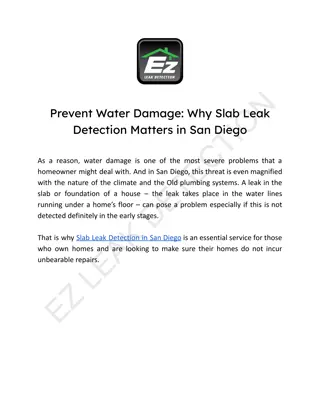EPA Compliance Basics: Tank Leak Detection and Monitoring Methods
Learn about EPA requirements for tank leak detection, release detection methods, and compliance methods for monitoring tank systems. Understand the importance of implementing effective leak detection systems to prevent contamination and comply with federal regulations, including Automatic Tank Gauging (ATG) technology. Discover the various monitoring methods, such as Interstitial Monitoring, Statistical Inventory Reconciliation (SIR), and more, to maintain regulatory compliance and protect the environment from hazardous leaks.
Download Presentation

Please find below an Image/Link to download the presentation.
The content on the website is provided AS IS for your information and personal use only. It may not be sold, licensed, or shared on other websites without obtaining consent from the author.If you encounter any issues during the download, it is possible that the publisher has removed the file from their server.
You are allowed to download the files provided on this website for personal or commercial use, subject to the condition that they are used lawfully. All files are the property of their respective owners.
The content on the website is provided AS IS for your information and personal use only. It may not be sold, licensed, or shared on other websites without obtaining consent from the author.
E N D
Presentation Transcript
Veeder-Root Company Presents: EPA Compliance Basics Presenters: Bill Tobias, Director of Sales, Veeder-Root Carlton Knowles, Territory Sales Manager, Veeder-Root
Topics Tank Leak Methods and Testing Maintenance and Inspections 2
EPA Requirements for Tank Leak Detection Section 280.40 All regulated tanks must have release detection so that leaks are discovered quickly before contamination spreads from the UST site. You must provide a method of release detection (often also called leak detection) that allows you to meet four basic requirements: 1. You can detect a leak from any portion of the tank that routinely contains petroleum; and 2. Your leak detection is installed and calibrated in accordance with the manufacturer's instructions; and 3. Your leak detection is operated, maintained, and tested in accordance with the manufacturer's instructions; and 4. Your leak detection uses one of the seven methods described in the federal regulations (section 280.43).
Release Detection Methods for Tanks Monitoring Methods-monitored every 30 days 1. Automatic Tank Gauging For tanks installed after April 11, 2016, Interstitial Monitoring will be the only permissible method 2. Monitoring for Vapor in the Soil 3. Monitoring for Liquid on the Groundwater 4. Interstitial Monitoring 5. Statistical Inventory Reconciliation (SIR) or 6. Weekly Manual Tank Gauging* 7. Annual Tank Tightness Testing + (Daily Inventory Control or Manual Tank Gauging)** * Limited applicability, tanks under 2,000 gallons ** Limited applicability, tanks installed < 10 yrs State and local regulations may differ from the federal requirements. Contact your local agency to ensure you meet those requirements.
Compliance Methods Method 1: Automatic Tank Gauging Systems An ATG system detects leaks through highly accurate inventory measurements combined with the tracking of delivery & dispensing activities What are the regulatory requirements? ATG must be able to detect a leak of 0.2 gallons per hour with a 95% probability of detection and with a false alarm rate of 5%. The ATG must perform Inventory Control The ATG must be operated in one of the following modes: ATG Magnetostrictive Probe Static testing (i.e. Veeder-Root s 0.2 SLD test) conducted every 30 days Continuous in-tank leak detection (i.e. Veeder-Root s CSLD mode) operating on an uninterrupted basis Example Equipment: An ATG that meets regulatory requirements (TLS-450PLUS) Probes with Leak Detection capability for each tank Leak testing software for CSLD
ATG Tank Testing Technology 1988 Static Leak Detection (SLD) annual (0.1 gph) precision test introduced 1981 Static Leak Detection (SLD ) monthly 0.2 gph precision test introduced 1994 CSLD for Manifolded 10,000 gal tanks 2015 CSLD for Manifolded 20,000 gal tanks 1994 2000 s 2016 Continuous Statistical Leak Detection (CSLD) introduced for single tanks 3.0 gph gross test added to ATG Interstitial monitoring grows in popularity Interstitial monitoring required for all new installations
Demonstrating Compliance with an ATG Method 1: ATG System using SLD A Tank Leak Test History PASSED TEST RESULTS should be printed or archived every 30 days
DemonstratingCompliance with an ATG Method 1: ATG System using CSLD A Tank Leak Test History PASSED TEST RESULTS should be printed or archived every 30 days
Compliance Methods Method 4: Interstitial Monitoring Interstitial Monitoring requires secondary containment Secondary containment provides a barrier between the tank or piping system from the environment The barrier holds the leak between the tank and the barrier so that the leak is detected. Example - Double-Walled Tank Construction Barriers include: 1. Double-walled USTs, in which an outer wall completely surrounds the primary tank Brine-filled for Wet Monitoring Dry Space (annulus) for Dry Monitoring 2. Impermeable excavation liners that partially or completely surround the tank. Installation of Interstitial Sensor 3. Internally fitted liners (bladders)
Compliance Methods Method 4: Interstitial Monitoring (cont.) Sensors for Interstitial Monitoring Dipstick with Water or fuel paste Non-Discriminating Liquid Sensors for dry space detects presence of any liquid Discriminating Liquid Sensors for dry space detects presence of hydrocarbons Hydrostatic Sensors for Brine-filled wet space detects a change in the level of a monitoring liquid between the walls of a double-walled tank. Secondary Containment Vacuum Sensing - checks for a change in condition that indicates a hole in the tank, such as a loss of vacuum Non-discriminating liquid sensor (fiberglass tank) Non-discriminating hydrostatic sensor What are the regulatory requirements? The interstitial monitor must be checked at least once every 30 days. Secondary Containment Vacuum Sensing Example Equipment: Interstitial Sensor ATG for continuously monitoring sensors
Demonstrating Compliance with an ATG Method 2: Vapor Monitoring Method 3: Groundwater Monitoring Method 4: Interstitial Monitoring A Sensor Status Report should be printed or archived every 30 days
What is the right compliance method for your site? Single Wall Tank Applications (Must choose one) 1) Automatic Tank Gauging System CSLD best solution for high throughput sites with little/no quiet period SLD best solution for sites with quiet period 2) Vapor Monitoring for low water tables not recommended due to delay in detection and potential for wet sensors. 3) Groundwater Monitoring for high water tables not recommended due to delay in detection. Contamination has already occurred 5) SIR Best solution for sites with monthly throughput above CSLD maximums and no quiet time 6) Manual Tank Gauging (< 2,000 gallons only) not recommended as tank is out of use >36 hours/week 7) Tank Tightness Testing + Inventory control
What is the right compliance method for your site? Double Wall Tank Applications (Must choose one) 4) Interstitial Monitoring best solution, prevents any contamination outside barrier 5) SIR 6) Manual Tank Gauging (< 2,000 gallons only) 7) Tank Tightness Testing + Inventory control
Revised EPA Regulation Timeline Oct 13, 2018 Owners and operators must conduct the first test or inspection: Spill prevention equipment testing Overfill prevention equipment inspections Containment sump testing for sumps used for piping interstitial monitoring Release detection equipment testing Walkthrough inspections Oct 13, 2015 Flow restrictors in vent lines may no longer be used to meet the overfill prevention requirement at new installations and when an existing flow restrictor is replaced July 15, 2015 EPA published the 2015 underground storage tank regulation April 11, 2016 Owners and operators must begin meeting the requirement for: Secondary containment and interstitial monitoring for new and replaced tanks and piping Under-dispenser containment for new dispenser systems
Changes to Operation & Maintenance Beginning Oct 13, 2018 owners and operators must Inspections: Conduct walkthrough inspections at their UST Facility every 30 days Testing: test electronic and mechanical components of release detection equipment annually Testing: test overfill prevention equipment every 3 years Testing: test spill prevention equipment every 3 years Testing: test containment sumps every 3 years No required testing of annular space of tanks No required testing of annular space of piping
Release Detection Equipment Testing No later than October 13, 2018 owners and operators must perform their first annual test to make sure release detection equipment is working properly. Test electronic and mechanical components for proper operation using one of the following options: Automatic tank gauge and other controllers Test the alarm Verify the system configuration Test the battery backup Probes and sensors Inspect for residual buildup Ensure any floats move freely Ensure any shafts are not damaged Ensure the cables are free of kinks and breaks Test the alarm operability and communication with the controller Automatic line leak detector Ensure the device activates (alarms, restricts flow, or shuts off flow) within an hour when simulating a release equivalent to 3 gallons per hour at 10 pounds per square inch Vacuum pumps and pressure gauges Ensure there is proper communication with sensors and the controller Hand-held electronic sampling equipment associated with groundwater and vapor monitoring Ensure the device operates properly Owners and operators must maintain records of release detection equipment testing for at least (3) three years. The record must include each component tested, whether each component passed the test or needed to have action taken, and any action taken to correct an issue.
Questions / Contact Information Technical Support 1-800-323-1799 M-F 8am to 7PM Eastern Time technicalsupport@veeder.com www.veeder.com/support
